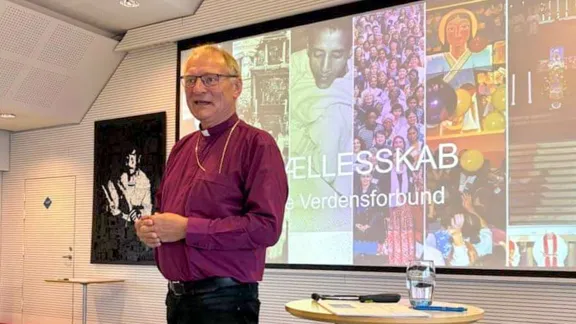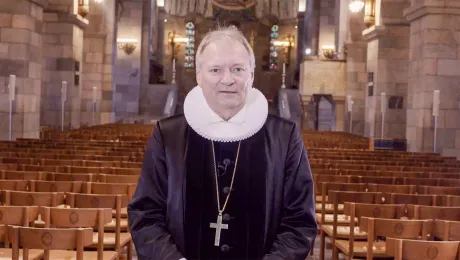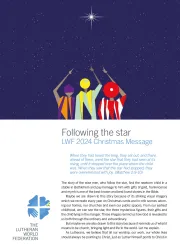
LWF President Bishop Henrik Stubkjær in Ilulissat, Greenland. Photo: Evangelical Lutheran Church in Denmark
LWF President Stubkjær attends a pastoral conference and discovers more about the Greenlandic way of life
(LWI) – It is the world's biggest island, as well as the most sparsely populated nation on earth, with over 80 percent of its territory covered in ice. Greenland, with a population of just over 57,000 people, of whom more than 90 percent belong to the Lutheran Church. It was here, to Ilulissat on the island’s western coast, that the Lutheran World Federation (LWF) President Bishop Henrik Stubkjær travelled recently to attend a conference of local pastors under the leadership of their Bishop Paneeraq Munk.
Formerly a diocese of the Evangelical Lutheran Church in Denmark, Lutherans in Greenland are busy trying to forge a new identity as the island seeks independence from its former colonial rulers. Although Greenland gained autonomy from Denmark in 1979, a new draft constitution was unveiled last year setting out terms for full independence, including over its foreign affairs, defence and monetary policy.
“They are a proud and independent people,” says President Stubkjær, who also serves as bishop of the Danish Diocese of Viborg. “There is a close connection between the church and society, so from the church side now, they really have to work on being well represented in the new constitution.”
Lutheran identity and Inuit traditions
Reflecting on his encounters during the 9 to 13 September visit, Bishop Stubkjær notes that there are around 22 pastors in Greenland, many of them living in extremely isolated places. “It is only every second year that they have this kind of pastoral conference where they can all get together,” he says, “so it was really a joy for them to be there and to be able to discuss the challenges with their bishop.”
Greenland faces many challenges, including a high suicide rate, especially among people from remote villages who struggle to adapt to a rapidly transforming way of life. Bishop Stubkjær says the church is trying to reach out to help the most vulnerable communities. “During the seminar, I was asked to lead a discussion on Lutheran identity, how to be a diaconal church in Greenlandic society and how to merge Christianity with Inuit traditions.”
It is vital for the church in Greenland to feel connected to the wider Lutheran communion.
LWF President Henrik Stubjkær
One example which Bishops Stubkjær points to is the use of drums which play a major role in indigenous culture and religious practises. “They are asking is it possible to be innovative and to bring these drums into a Christian worship service? For some of them, it is possible. For others, they say no, we are not there yet.”
The LWF leader says it is vital for the church in Greenland to feel connected to the wider Lutheran communion. “I presented to them some of our programs, for example for newly elected leaders and I also brought them the resolution on indigenous people from the Krakow Assembly. Some of the pastors came up to me and said this is exactly what they need in order to build up and strengthen their own identity.”
Communications and internet technology remain difficult in some of the remotest parts of the island, but Bishop Stubkjær says one of the goals of his visit was to foster closer ties with the LWF. Although they are part of the Danish church, he says Greenlanders “are on the same track as the Faroe Islands [another former Danish colony] where they have started to negotiate with us in the LWF to see how they can be more closely connected to churches in other parts of the world.”
Mutual learning opportunities
He continues: “I think we can learn a lot from them about how they connect to the people and to their society. They are very Lutheran in their liturgy and they are also a modern church in many ways, for example there are many more women pastors than male pastors. I think there could be a very exciting dialogue between members of the church in Greenland and some of our churches in Latin America or in Africa, where they are struggling with similar challenges but have found different solutions.”
Another significant challenge is the way that climate change is altering traditional ways of life, making it impossible to use dog sleds for transport in areas where packed ice has melted. “By nature, Greenlanders are hunters and fishermen, but it is very clear that change is happening fast and they are having to adapt their ways of living which is a huge challenge for the whole of society,” he says.
Despite their challenges, Bishop Stubkjær says the people are “very welcoming and positive as they confront the task of building up the church. For me, as a Danish bishop, it was an inspiring learning process to be there and to strengthen relations with Bishop Munk. Although she attends our Danish church meetings, it was great to see how she engaged with all the pastors and there was a very good spirit there. I think we could really learn a lot from their example and their way of being church.”


